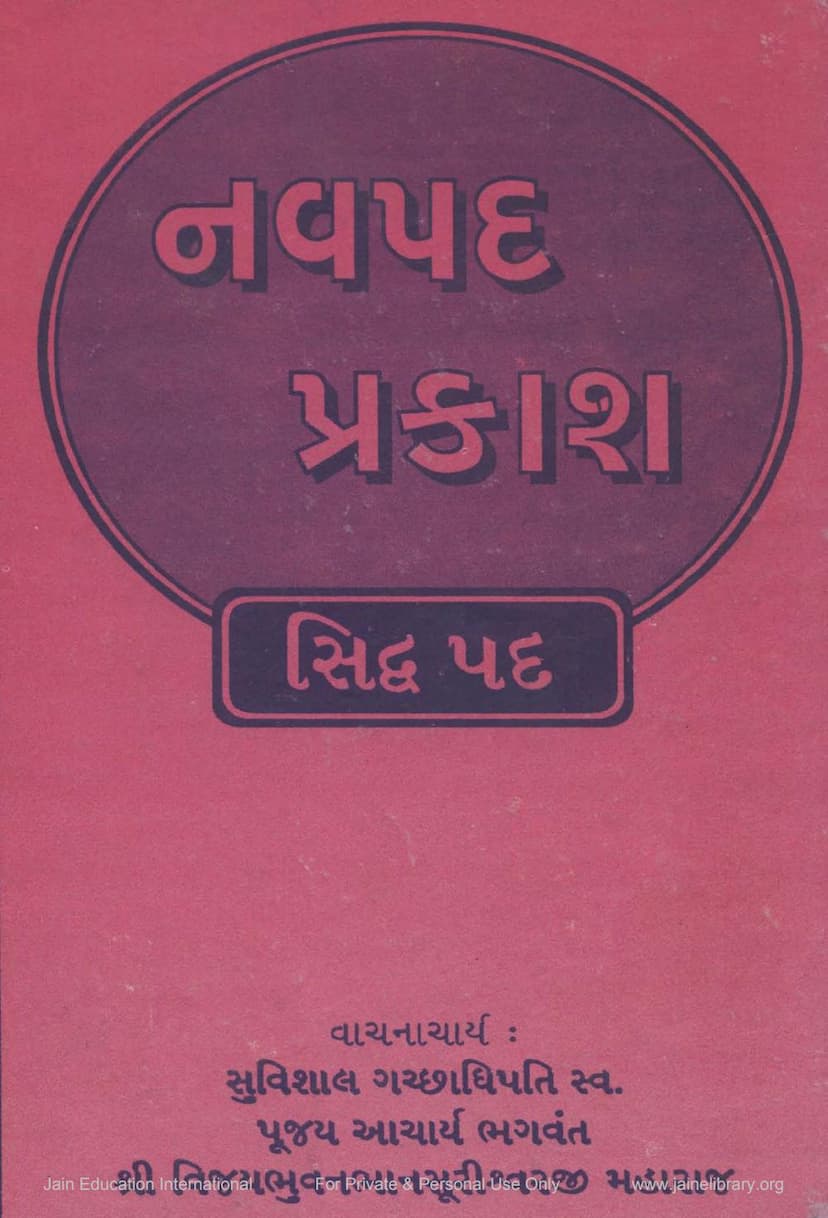Navpada Prakash Part 2
Added to library: September 2, 2025

Summary
Here's a comprehensive summary of the Jain text "Navpada Prakash Part 2," focusing on the "Siddha Pad" section:
Book Title: Navpada Prakash Part 2 Author: Bhuvanbhanusuri Publisher: Divya Darshan Trust Catalog Link: https://jainqq.org/explore/004983/1
This book is the second installment of the "Navpada Prakash" series, dedicated to elaborating on the "Siddha Pad" (the state of liberated souls) of the Jain Navpada (Ninefold Path). The text is based on discourses delivered by the esteemed Acharya Bhuvanbhanusuri.
Core Message:
The central theme is the profound significance and realization of the Siddha Pad. The text emphasizes that the Navpada – Arihant, Siddha, Acharya, Upadhyaya, Sadhu, and the three jewels of Darshan (Right Faith), Gyan (Right Knowledge), and Charitra (Right Conduct) – are the essence of Jainism. Attaining liberation (Moksha) is impossible without the worship and adherence to these nine components. The book aims to reveal the hidden secrets and profound meanings within the Navpada Puja (worship) composed by Upadhyaya Yashovijayji Maharaj.
Key Themes and Concepts Discussed for Siddha Pad:
-
Nature of Siddhas:
- Udasinata and Nirvikarta (Detachment and Equanimity): Siddhas are described as being indifferent and devoid of emotions towards the world. This state is our true soul's nature. By meditating on this, one attains immense joy, peace, and strength.
- Freedom from Karma: Siddhas have destroyed all eight types of karma, thus transcending birth, old age, death, and fear.
- Infinite Attributes: They possess infinite knowledge (Gyan), infinite perception (Darshan), infinite power (Virya), and infinite bliss (Sukh).
- Soul's True Form: Siddhas are described as "niravaran" (uncovered) and "atm-swaroop" (in their true soul form).
- Joti-roop (Luminous Form): They are considered luminous, representing the radiant nature of the soul's knowledge. This is not a physical light but the manifestation of pure consciousness.
- Avyabadh (Unimpeded) and Apunar-bhav (No Rebirth): Siddhas experience uninterrupted bliss and are free from the cycle of rebirth.
-
The Path to Siddhahood:
- Destruction of Eight Karmas: The primary means to achieve the Siddha state is the annihilation of all eight karmas.
- Meditation and Contemplation: The text stresses the importance of meditating on the qualities of Siddhas to internalize their state.
- Anumodana (Appreciation/Approval): By appreciating and approving of the Siddhas' state of unconditional bliss, one plants the seed for attaining it.
- Detachment from Worldly Pleasures: Understanding that worldly pleasures are "sopadhik" (with conditions) and temporary, while the Siddha's bliss is "nirupadhik" (unconditional) and eternal.
- Striving for True Wealth: True wealth is the soul's inherent spiritual capital, not material possessions.
-
Understanding the Siddha State:
- Siddha's Bliss: This bliss is "nirupadhik" (unconditional), pure, and free from any admixture of suffering, unlike worldly happiness.
- Anant Chaturusk (The Four Infinitudes): The four infinite qualities (Gyan, Darshan, Virya, Sukh) are central to understanding the Siddha state.
- Dravya-Kshetra-Kaal-Bhav (Substance-Space-Time-Mode): The text uses these four principles to explain how Siddhas possess infinite qualities in their essence, space, time, and modes of existence. This detailed analysis illustrates the "gunan" (qualities) of the Siddhas.
- Ineffability of Siddha's Bliss: The joy and qualities of Siddhas are beyond description, much like a villager cannot accurately describe a city's grandeur.
- The Meaning of "Bhavit" (Imbued/Influenced): One becomes "bhavit" (imbued) by contemplating the Siddhas, leading to the manifestation of their qualities within oneself.
-
Practical Guidance for Sadhana (Spiritual Practice):
- Nishkam Bhakti (Selfless Devotion): True devotion is not seeking worldly favors but connecting with the pure, liberated state of the soul.
- The Role of Prayer: Prayer instills a strong desire (abhilasha) for liberation and fosters a connection with the divine.
- Contemplating the Siddhas: Regularly contemplating the Siddhas, their unwavering peace, and their freedom from worldly influences helps one cultivate similar qualities.
- Developing Inner Strength: The contemplation of Siddhas provides the "power" to remain unaffected by worldly dualities (pleasure/pain, honor/dishonor).
- The Importance of "Anu-samvedan" (Experiential Understanding): True understanding comes from internalizing the qualities of the Siddhas, not just intellectual knowledge.
- Avoiding Attachments: The concept of "asanga" (non-attachment) is crucial. This involves letting go of attachments to both pleasant and unpleasant worldly experiences, and even to one's own spiritual achievements.
- The Analogy of the Yogi: The story of the yogi who declared himself the "king of kings" illustrates the ultimate freedom and self-sufficiency of the Siddha state.
- The Power of "Logass" Sutra: This sacred verse is highlighted as a tool for contemplation, allowing one to focus on the detached and pure nature of the enlightened ones.
-
The "Siddha Pad Puja" and its Explanation:
- The text includes explanations of various verses from the Siddha Pad Puja, dissecting their meaning and spiritual implications.
- "Namo Namo" (Repeated Salutations): Explains the significance of repeated salutations as a gesture of continuous reverence and the ongoing aspiration to attain the Siddha state.
- "Ananta Chaturuskaya Namah": Salutations to the Siddhas for possessing the four infinite qualities.
- "Kari Asht Karma Kshaye Param Pamyā": The path of destroying karma leading to liberation.
- "Janam-Jarā-Maranadi Bhaya Jene Vamyā": Freedom from the fears of birth, old age, and death.
- "Niravaran Je Atmarupe Prasiddha": The soul revealed in its uncovered, pure state.
- "Sada Siddha Buddhā": The eternal state of being liberated and enlightened.
- "Tribhāgon Dehavagaha Aatmadeśa": Discusses the subtle spiritual form of the Siddha.
- "Sadaanand Saukhyāshrita Jyotiroopa": The eternal, luminous state of bliss.
- "Avyabadha Apunarbandhadiswarupa": The state of unimpeded existence and no rebirth.
Overall Purpose:
"Navpada Prakash Part 2" serves as a guide for spiritual seekers to understand and aspire to the Siddha Pad. It provides philosophical insights, practical meditation techniques, and devotional explanations to help individuals progress on the path of liberation, emphasizing the transformative power of contemplating and emulating the qualities of the Siddhas. The book encourages readers to shed worldly attachments and cultivate the innate virtues of the soul, ultimately leading to the attainment of everlasting peace and bliss.